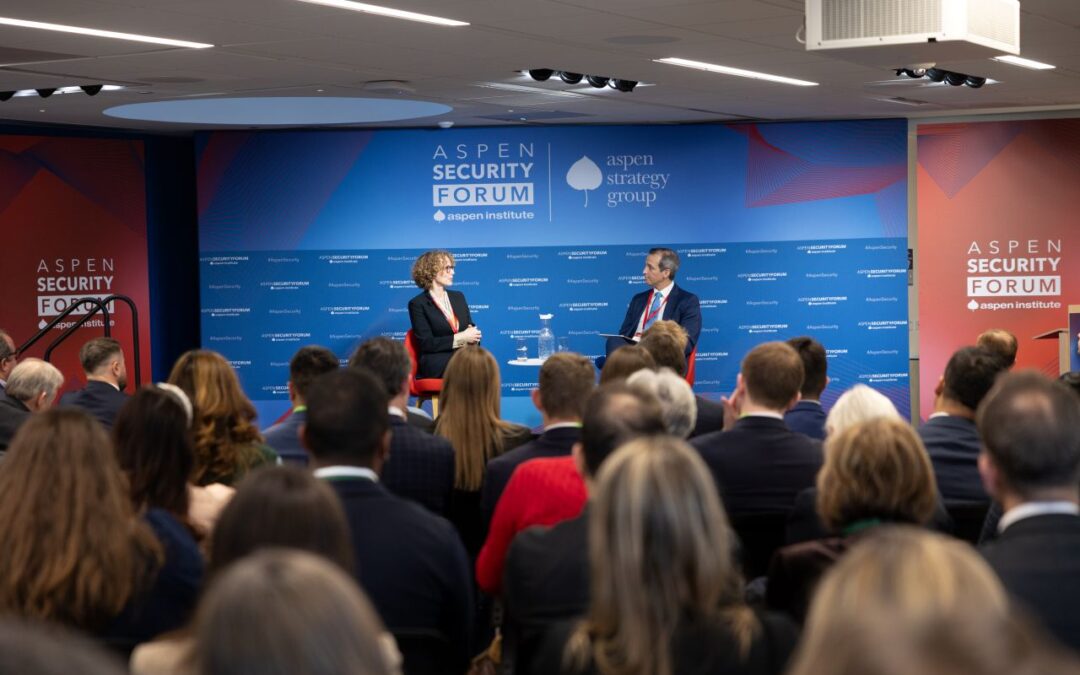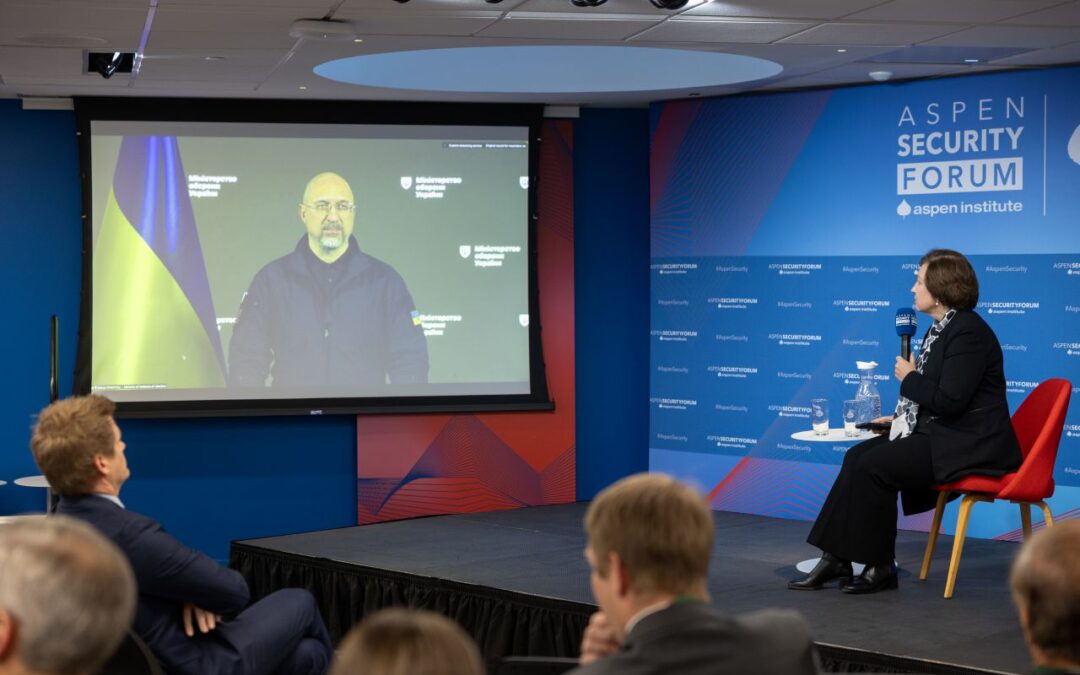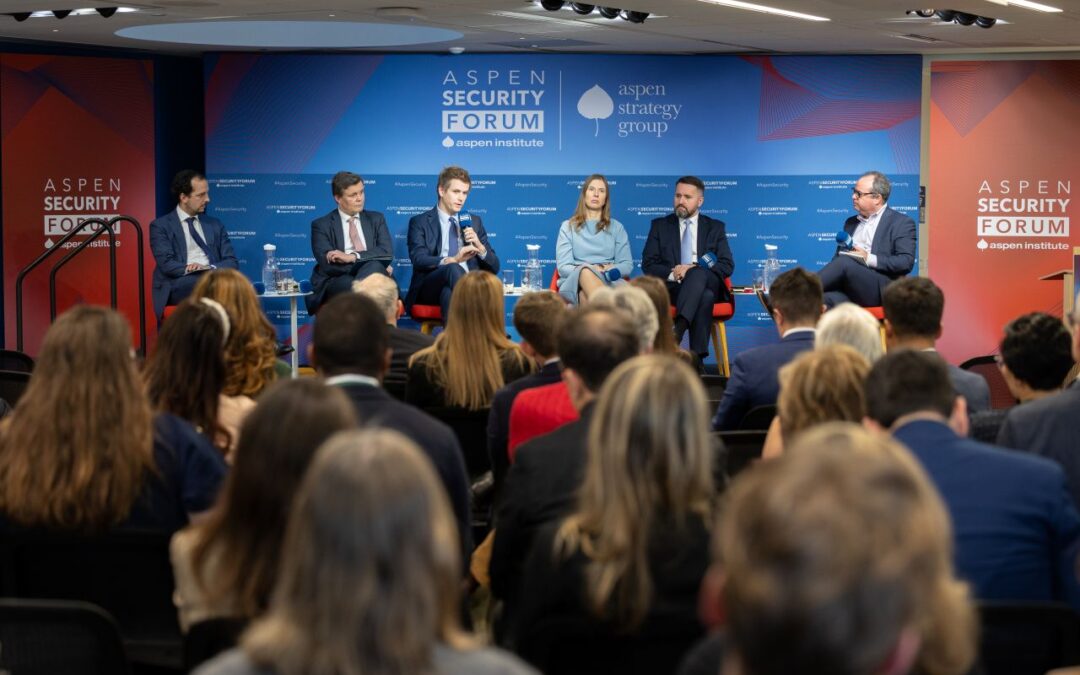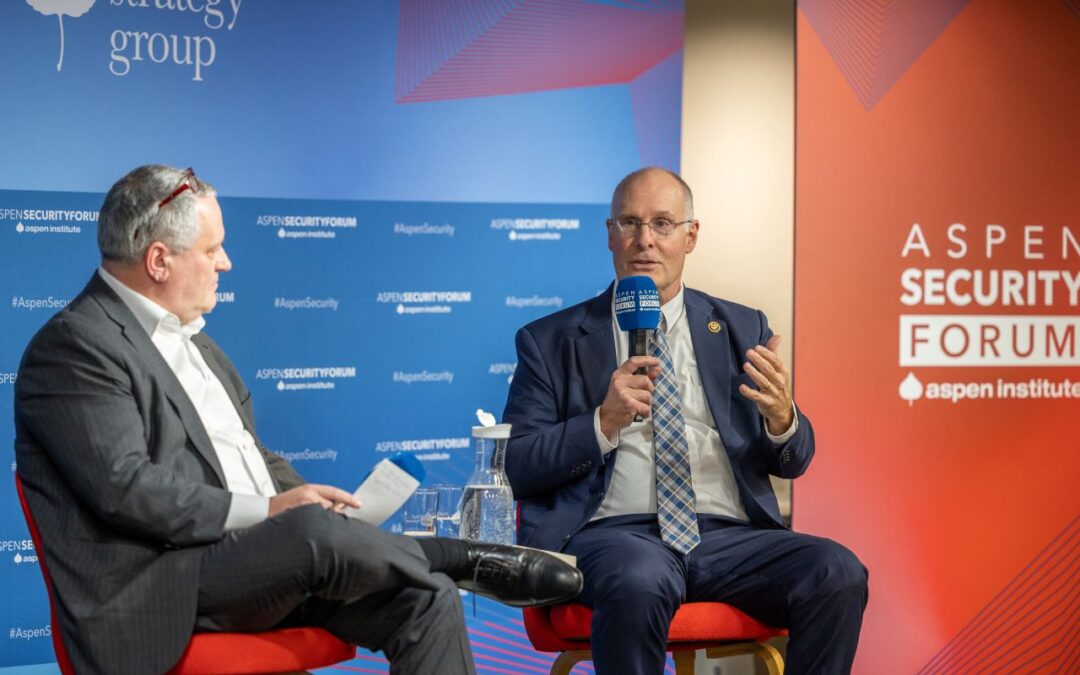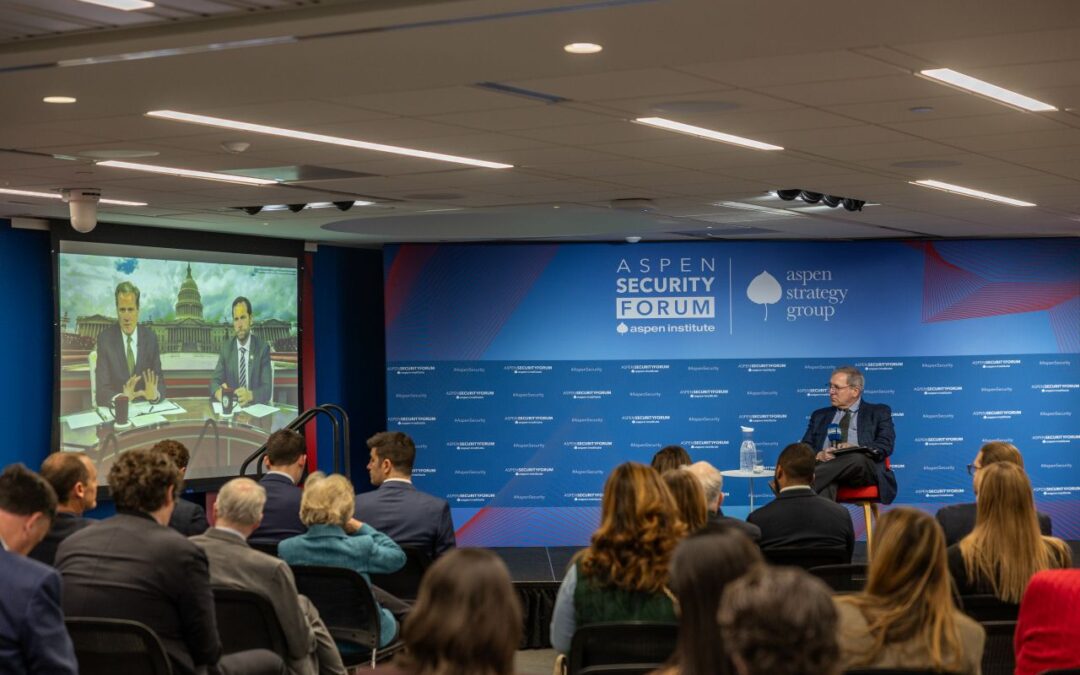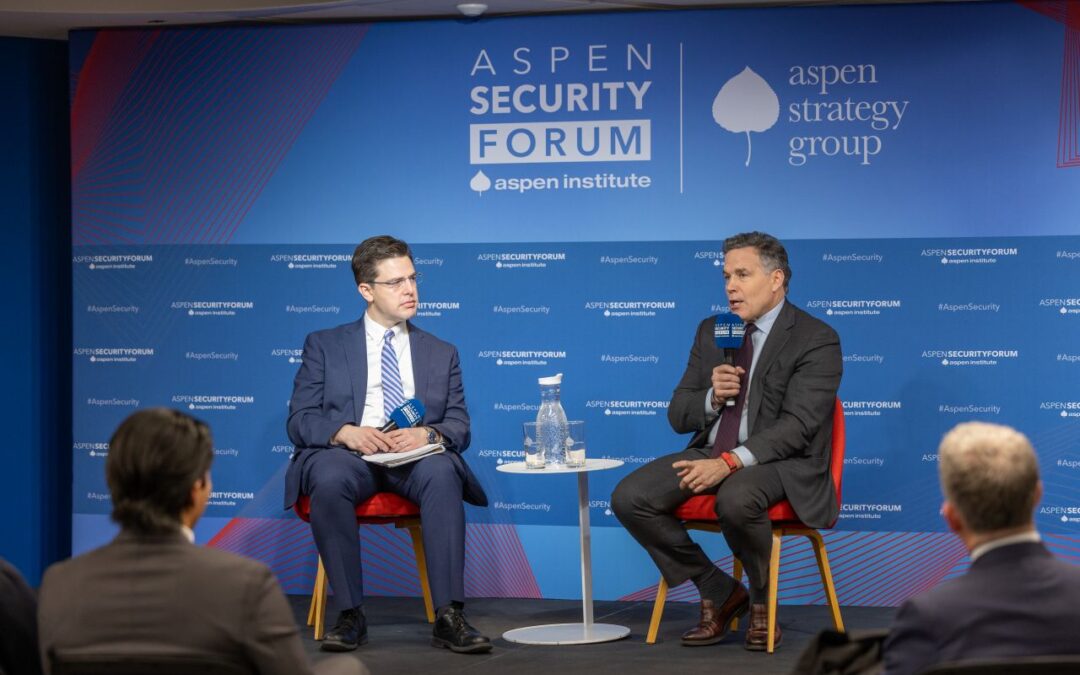Speakers
Alberto Alberto, Senior Policy Advisor, CHIPS National Semiconductor Technology Center, U.S. Department of Commerce
Grant Cuprak, Defense Strategist
Matthew Hauwiller, Senior Engineer, Seagate Technology
Tina Huang, Wadhwani AI Center Adjunct Fellow, CSIS
Rahaf Safi, Foreign Service Officer, U.S. Agency for International Development (USAID)
Moderator: Niamh King, Director, Aspen Strategy Group and Aspen Security Forum
Full Transcript
Read the full transcript below or download it to your device.
Click to read the full transcript
Niamh King:
One of the pillars of our work at the Aspen Strategy Group and Aspen Security Forum is our Rising Leaders Program. We started it four years ago. We’re in the process of recruiting our fifth class, so if you have anybody fantastic in your network, please check out our website. The applications close this Sunday night at 11:59 PM and one of the key things that our rising leaders do is they write a paper, and today we publish the book on the rise. So I’d encourage you to go to our website and check it out, and I’m absolutely delighted to have five of the authors here on stage today for a little while so they can tell you about, the senator was just talking about looking at solutions. These guys have some great ideas to some rather vexing global issues. So rather than me introduce them, I’m going to have them introduce theirselves because some of them are here in their private capacity, so they might whisper what they do to you, but they’re not doing that as whatever they’re working on. I’ll start down the end with Grant. Grant. Just give us a brief introduction of yourself please and then we’ll get to your paper after.
Grant Cuprak:
Grant Cuprak defense strategist. I’m a transitioning Army officer.
Niamh King:
Great, Alberto.
Alberto Alberto:
Good afternoon everyone. Alberto Alberto. I currently work at the Department of Commerce, all views of my own in my own personal capacity. The lawyers are happy now.
Niamh King:
Matt,
Matthew Hauwiller:
I’m Matt Hauwiller. I work as an engineer in data storage technologies and I work a lot with universities doing research collaborations both in the US and around the globe.
Tina Huang:
I’m Tina Huang. I’ve been working what I call the soft skills of AI for the past six years, so AI policy, national security, respons governance and so forth.
Rahaf Safi:
I’m Raha Safi. I have largely been working in the humanitarian sector with non-governmental organizations. Started off as an aid worker based in the Middle East and slowly transitioned to other roles.
Niamh King:
Terrific, thanks. And actually what I would really like to do is have the rest of the rising leaders in our audience, would you please stand and we’ll give them a round of applause. This class and previous classes. Thank you so much. This is America’s foreign policy and national security future and I couldn’t be more delighted. Alright, grant, I’m going to kick it over to you, your paper with a hat tip to other famous Washingtonian present at the recreation. Does missile technology control regime still serve America’s most important interests? Well, I think you can answer your paper’s Question for us. Why don’t you give us the answer?
Grant Cuprak:
Yes. First, we had a tremendous group, so thanks to a SG for all of the help in curating speakers and reviewers. We had an awesome group that looked at this, Alison Allegra and Corey, ICVC, industry defense space, so it was a fun project. That being said, all views are our own. They don’t reflect our institutions. And then also the paper is not going to be published just yet. It’s through three of four government reviews, so hopefully at some point soon it’s published. Everyone is well aware of the export controls. Right now on chips, we are seeking to restrict what China has. There’s something similar for missile technology and also for drone technology. And this goes back to the 1980s. The difference though between the MTCR, the missile technology control regime from the 1980s and the export controls right now that Alberto and others are doing great for America is the fact that the default for the MTCR is no, regardless of who it’s going to.
It’s not just Beijing, it’s everyone. No, no, no long range missiles to Australia, no long range missiles to Japan, no sharing technology with Poland. No, it’s a significant issue for us and we kind of articulate why, and this isn’t some sort of generational like us punching up to the previous generation. You can really see in the declassified NSC documents where the NSC was grappling with the non-proliferation concerns at the time of the eighties and nineties and how they were adapting US policy for that. But at the end of the day, we kind of arrive at three issues with the MDCR right now for American interest. First is that it goes against the technology trends, missile and drone technologies becoming increasingly ubiquitous. And this default no is an issue for us and will continue to be so the toothpaste is out of the bottle. The second thing is that it significantly exacerbates the operational dilemmas.
The Department of Defense faces throughout the world. It makes our allies weaker and then it also increases the level of sophistication, the expensiveness of forces we have to deploy. And it also increases the chances of catastrophic risk for our country. So that doesn’t make sense either. It also contributes to a brittle defense industrial base. The last thing is, despite the numerous pronouncements about the role of allies and partners and how it’s our competitive advantage and enduring advantage and all that, this actually doesn’t allow us to unlock the allies we have when the default is no with all of our closest allies. And we can’t share technology. It hamstrings our ability for this long-term competition that we have with the PRC in this century. We provide some policy recommendations with that, which I won’t get into because of the pending review of the paper, but I really think this is kind of a generational reconsideration of something that had made sense in the late Cold War came of age in the 1990s at the height of American Power. But ultimately what we kind of look at in the paper is does this still serve our interests? If we’re doing something like this, it ought to serve our interests. We ought not to be doing it just because we’re used to doing it. So thank you.
Niamh King:
Thanks Grant, and thanks for mentioning your co-authors. Alberto, over to you next, maybe mention your co-authors and tell us about your paper too. Thanks.
Alberto Alberto:
Thanks Steve. Seconding everything that Grant said, huge thank you to Des Secure Forum and Gas Institute for everything on our paper. Matt, who’s here to my right, was one of the co-authors and there was another person that I can’t name right now, but it was an amazing experience to co-write this paper with you all and really just kind of think through these really tough issues that we discussed in our paper. So in a nutshell, what we essentially looked at was how can federal government agencies that focus on national security issues and investing in critical technology to address those issues, what can they do to be more efficient and just really meet the needs that we have to do at a rapid fire pace. So just to do a little bit of a level setting, so to set things up, one, there’s the geopolitical dynamics, right?
We have recent US support and preparation for war across Europe, middle East and Asia. And not only preparation, but really there’s now a huge focus on the technologies that are needed in order to meet the needs to be able to compete effectively. Two is the pace, public sector, private sector, civil society, whoever you talk to, everyone knows and everyone agrees that whatever it is that we’re doing, we need to do a lot quicker. And then three is culture. Within these organizations, different departments across the federal government, they have their own missions and their missions dictate their culture and how they do things. And that really goes from top to bottom and it dictates just how they implement their programs and how they think about what’s important and how to use federal tax dollars. That’s something that really resonated with us in the security forum in Aspen, was something that the IU dug back said, which he said it’s not policy if it’s anything.
Most often it’s culture and they’re working really hard to put wind on the board to change the culture. But we wanted to take things a step further by saying beyond wins, what else can happen or what else can we do? And that solution was the mindset. We think that agencies for their portion of the work that is in investing critical technologies, our recommendation is that they should look at the venture capital mindset, which is take a portfolio approach to the work that you do. And not only that, when you take a portfolio approach that you’re making bets across the board and you’re making sure that the wins outlast and are bigger than your losses. When you do that, you give opportunity to different companies, different technologies, and you have a higher success rate and you’re not so bogged down to individual investments.
The other thing I would say is that there’s examples of this. We have NASA Starliner program, which for those of you that don’t know is NASA’s program to shuttle people, people, and items are from here to in the international space places. I’m not the technical guy here, that’s one. And then two, you also have doe’s loan program office for NASA from 2010. They initially started with about $50 million for five different companies. 2011, that increased almost fivefold to about 270 and it was four companies and then 2014, Boeing SpaceX, billions of dollars while they have their own issues and things will work out. It’s a representation of the fact that you need to take bold bets to meet these needs. I’m almost wrapping up on DOE. Their loan program office is about 33 billion disbursed funds of that, it’s about 3.1% of that disbursed funds are actual losses. They’ve received about almost 5 billion in interest payments and about $14 billion have been principal repayments. That’s huge. That’s a win. That’s important that we should be celebrating that and we should be adapting these two approaches to other parts of the government that invest in these critical technologies. There’s something that we talked about when we’re preparing for this panel was efficiency. I think that that’s something that I really into
Niamh King:
People’s mind and I to be a little efficient with work.
Alberto Alberto:
Yeah. Yeah. So I’ll stop there and then we can get to it later on.
Niamh King:
That’s great. And please, during the coffee break, feel free to approach the authors. Matt, over to you. You’ve got two efficient minutes to get through and tell us about your great paper.
Matthew Hauwiller:
Thank you. And thank you to everyone who helped with this. Ric was a co-author on this paper with me. Africa has a wealth of young, bright minds and business opportunities, but unfortunately we’ve seen our adversaries, China and Russia make great inroads on the continent. And so what we tried to look at in this paper was, are there alternative diplomatic means we can use to help build soft power on the continent and help gain some influence with the people and the governments there? We specifically looked at two aspects, agriculture and tech. Agriculture is very important. Food security is a very large challenge in Africa, and the US is a world leader in agriculture. This provides a unique opportunity to collaborate both in the distribution of food and in the research and technology. On the technology side, the US has a world leading space in both the universities and in business.
As part of this paper, we did a poll of some professors and graduate students in Africa asking them what the top universities and tech companies were. And predominantly they picked companies and universities in the west and mostly in the United States. People in Africa want to study at our universities. They look up to our technology companies. This is a soft part that we can leverage to help build connections across the continent. Some of our recommendations included giving opportunities and expediting passports for people in Africa to study in the US and work at US companies. Additionally, we propose creating research centers on the continent jointly supported by their governments and the US to help research some of these technologies, especially around climate and other things that are affecting people on the continent. I think these sort of proposals are win-win wins, the people on African continent win, the government’s win and the American people win. As we look at the new administration bringing in more America first policies as they view foreign policy, we’ll see that agriculture affects people in rural communities and they’ll benefit from these policies as well as the tech sector in the United States seeing these new business opportunities which are very rich and have a great opportunity going forward. So if we can build these collaborative relationships between private sector governments and the people in Africa, we could see a lot of positive movement in the diplomacy side as well.
Niamh King:
Thanks so much Matt, and thanks for being efficient. Tina, over to you on ai. Thank you. Yes,
Tina Huang:
Thank you. I just want to first give a shout out to my two awesome co-authors, Eliza, me over here and I think Rachel Brooks is there in the back. So AI is evolving. That’s not breaking news, but it is challenging all of us to keep up with all the capabilities and for policy leaders staying afloat of the latest AI advancements is even more pressing in consideration of the great power competition we’re in right now. So we’re all aware of chat GPT, but how does it measure up to our Russian, Chinese or European counterparts? And so to better understand where the US stands in the world when it comes to AI innovation and to ensure that we are innovating responsibly, our leaders need to be equipped with the knowledge to be asking the right questions so they can make informed decisions. So that’s why my co-authors and I proposed creating an AI model card for policy audiences.
So this would essentially be a concise document that provides details about an AI model in plain language. Now the idea of an AI model card was first introduced in 2018 by a group of Google researchers, and it was to increase transparency throughout the AI life cycle. So as an AI model moved within internal teams within a company, a model card with a company that model, so that each team could see where that model was, what concerns or limitations that that model has so that they can work on it appropriately. Now, while this has been really valuable for technical communities, it doesn’t meet the specific needs for policy leaders yet because they not only need to understand the technical capabilities of these new systems, but also the societal and national security implications. And so we put forth in our policy model card that you have to have the basics, understand the purpose of a model, what’s its intended use case, why was it created its capabilities and limitations, so what can it do?
And probably more importantly, what can it not do? But then we also offer some policy angles to include. So the first is looking at international counterparts, like I mentioned before. Is there a way that we can meaningfully evaluate whether this US model is six months ahead or three months behind an international counterpart? Are there any cultural factors of different countries that might be boosting or inhibiting AI progress? The second policy component is AI’s impact on society. So this is thinking about the second, third, fourth order effects of how introducing an AI model in one sector could bleed into another sector. So overall, this policy model card is just one tool to connect AI innovation with governance. And the need for DC and Silicon Valley to be communicating is ever more important today. And when I say communication, I mean effective communication. So we cannot be communicating in hopes that our audience is understanding what we’re saying. We have to communicate so that there is no room for misinterpretation or miscommunication. And AI policy cards are a step in that direction to enable our leaders to ensure that we remain a leader in ai.
Niamh King:
Great, thanks Tina. And now lastly over to Raja. And we think Deputy Secretary General Muhammad’s team might be in the room and your paper is relevant to that. So you’ve got two minutes. Thank you.
Rahaf Safi:
Great, thank you. And just an acknowledgement to one of my co-authors, Amanda as well, who’s here, and another one who unnamed as well, but was very invaluable in contributing to the paper. So to situate the topic, we looked at advancing US statesmanship in the multilateral arena. So specifically we looked at the United Nations countering the competition with the PRC. And in that space, to just take a step back, it’s been 80 years since the Bretton Woods Conference first came together where part of the multilateral arena was first discussed in that in terms of the International monetary fund and in what later became the World Bank. The idea drew together at that point, and around that same time, the UN charter was also signed. So these are huge steps, huge milestones that the US was a part of, led in very strategic ways. The leadership was very critical to what became the multilateral arena in the post World War II era.
And we thought this was a very important topic to look at as we continue to see some of the changes that are happening. So in terms of what’s going on right now, we’re seeing the PRC take and leverage what was formed in this era and where the US led a lot on some of these issues and leverage these institutions to push forward its own development and security objectives and agenda. And in the space the US has changed and evolved its own leadership. And what we wanted to understand was some of those issues. So for example, one of the things that the PRC has been doing is relying on what is known as mini lateralism or a concept in which they’re building these discreet coalitions with different actors or different developing nations, and they’re incurring favor and driving influence in those areas to be able to push forward their own objectives.
It is an approach that the US has used as well, but we want to also make sure that we described in our paper as well, is that the multilateral space remains critical and important in that in driving the objectives and in driving the work that had been done and we put forward some recommendations. And in those recommendations we’re looking at how we can invest in human capital from individuals in the US to be able to join the spaces, the UN spaces. We’re also looking at how we can continue using our own current development and tools. And one quick note even about our co-authors, the three of us, I mean, we work across, and maybe I should have caveated this first by saying I’m speaking in my personal capacity right now, and as well as my co-authors as well, but we represent the different sides of development, defense, and diplomacy. So working across this arena, the US has been very strong historically in bringing these three together. So how do we continue to leverage that and continue to work with developing nations who are seeing this area of competition? They’re being pulled in different directions, in ways that help strengthen their own systems, and yet we maintain a space where we can drive forward those solutions and not lose that strategic edge that we’ve had.
Niamh King:
Great. Thank you so much. Thank you to all of you. And if you’re ever feeling pessimistic about the world, go check out this program of ours and I guarantee you’ll feel better. Let’s give a big round of applause and get ready for our next speaker.


